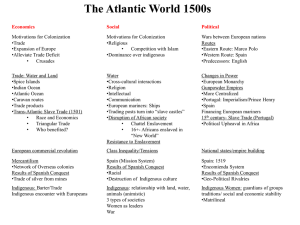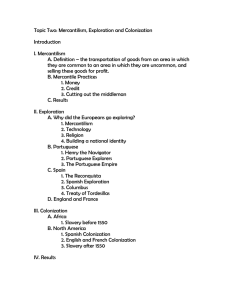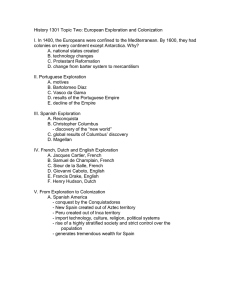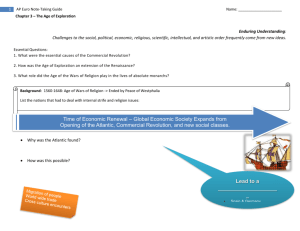2015 Lecture One- Disrupting an _Old World,_ to Create a _New World._ (5).ppt
advertisement
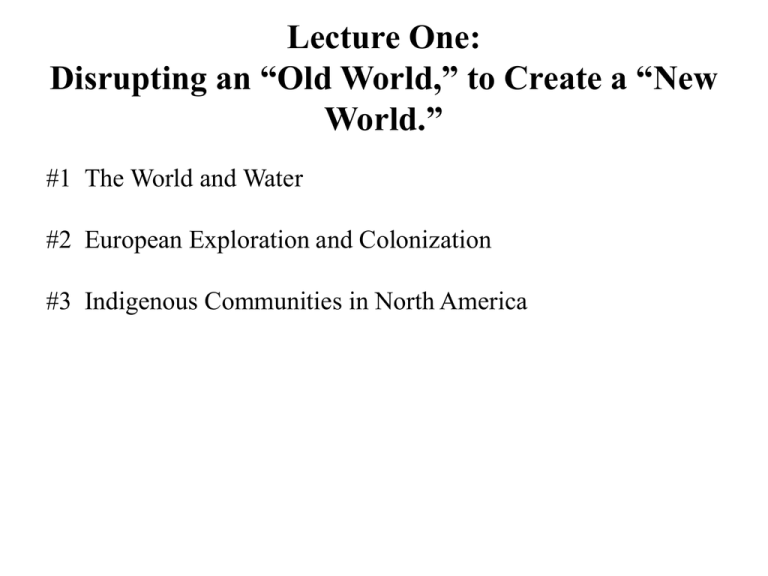
Lecture One: Disrupting an “Old World,” to Create a “New World.” #1 The World and Water #2 European Exploration and Colonization #3 Indigenous Communities in North America #1: The World- 15th Century By 1500 •Geo-political map: trade, conflict, and disease •Spice World: Japan, China, Molucca Islands, Borneo, Sumatra, India •Gunpowder Empires: Ottoman Empire, Portuguese, Spanish, Safavid, Russia •Rodolfo Acuna: Occupied America: Spain in North America: violent disruption 15th and 16th Centuries •Era of Western global exploration, expansion •Warfare- land and religion-played out in “New World”- Spanish verses English •Foundations for “contact and conquest”- Africa, Meso-American states Water: Cross-Cultural Interactions • Commercial • New trade routs= increase in port cities • Merchant houses in Europe • Mercantilism • Network of over-seas European colonies • Supported by war • Triangle Trade= enslavement in New World • Cultural- Religion and Ideas • Biological • Food crops, animal stocks, disease (The Columbian Exchange) • European mariners • New sea routes to markets of Asia • Direct contact with sub-Saharan Africa and Asia • Gave rise to early modern history 1500-1800 (the Atlantic World) • 15th century, Portuguese, Spanish, Dutch trading posts on coast of West Africa • “Liquid foundation”- empire building/ conquest of “New World” #2: Motives and Support Systems for European Exploration • Motives • Economics • Religion • Adventure/Fame • Occurred • Emergence of centralized European monarchies • Sufficient wealth to finance endeavors • New technologies: maps, charts, ships, compass, knowledge of winds • Support System • Transportation networks • Silk Roads in China • Caravans in Sahara desert • Sea-lanes: Water: Indian, Atlantic and Pacific Ocean basins Europeans and the Columbian Exchange Exploration and Colonization in the “New” World China: Indian Ocean Basin Portuguese: Africa’s west coast 15th century •Goals: expand Christianity/ Commercial activities •Colonization of Atlantic Islands •Indian Ocean trade • Muslim intermediaries • Portuguese ships with cannons=European imperialism •Christopher Columbus: plan rejected by Portuguese/sponsored by Spain Spain: Violent intrusion into Americas •Conquistadors- 1519- Hernan Cortes •Encomienda System •Natives became Spanish subjects •Catholic Missionaries: “a double-edged sword” • Protestant Reformation intensified national rivalries •Decline of Indigenous population- import of enslaved Africans • Results of Spanish conquest Historical Snapshot: The Explorer and the Lady Hernando de Soto and Lady Cofitachequi 1539- Chiefdom of Coftachequi No Gifts Pearls and Diplomatic Maneuverings Desoto and the Tombs of the Dead Impact of Invasion Spanish Legacy #3: Indigenous Societies Physical Environments Three Types of Regional Cultures Matrilineal and Patriarchy Three Eras: • Paleo-Indian era • Archaic Era • Pre-Columbian Era Indigenous Communities Encounter European Invader Christopher Columbus- “Children of Nature.” Gender Assumptions of Indigenous Women Squaws Convinced of their own superiority… 4 Consequences of Contact Odd, Foolish, Strange Ignored Women as Negotiators Housing Body Odors Indigenous Perceptions of the Invader No Gifts Ignored Religious Rituals Food Preparation and Seasoning Images of Indigenous Women Pocahontas: The Noble Indian Princess Creation of the Squaw Media and Stereotypes
